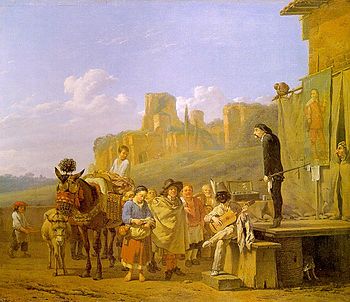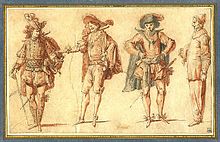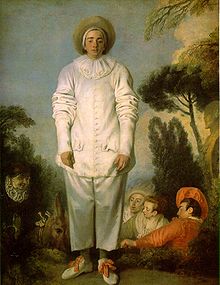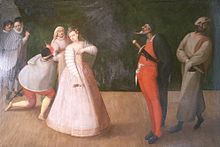- Commedia dell'arte
-
 Karel Dujardin, Commedia dell'arte show (1657) (Louvre).
Karel Dujardin, Commedia dell'arte show (1657) (Louvre). Greek • Roman • Medieval • Commedia dell'arte • English Renaissance • Spanish Golden Age • Neoclassical • Restoration • Augustan • Weimar • Romanticism • Melodrama •
Greek • Roman • Medieval • Commedia dell'arte • English Renaissance • Spanish Golden Age • Neoclassical • Restoration • Augustan • Weimar • Romanticism • Melodrama •
Naturalism • Realism • Modernism • Postmodern
19th century • 20th century (timeline)Commedia dell'arte (Italian pronunciation: [komˈmɛːdja delˈlarte]) is a form of theatre characterized by masked "types" which began in Italy in the 16th century, and was responsible for the advent of the actress and improvised performances based on sketches or scenarios. The closest translation of the name is "comedy of craft"; it is shortened from commedia dell'arte all'improvviso, or "comedy of the craft of improvisation". Here, arte does not refer to "art" as we currently consider the word, but rather to that which is made by artigiani (artisans).[citation needed] In fact, the term arte was coined much later, for in the early period the term used in contemporary accounts is commedia all'improviso. This was to distinguish the form from commedia erudita or learned comedy that was written by academics and performed by amateurs. Commedia dell'arte, conversely, was performed by professional actors (comici) who perfected a specific role or mask.
Italian theatre historians, such as Roberto Tessari, Ferdinando Taviani, and Luciano Pinto believe commedia developed as a response to the political and economic crisis of the 16th century and, as a consequence, became the first entirely professional form of theatre.
The performers played on outside, temporary stages, and relied on various props (robbe) in place of extensive scenery. The better troupes were patronized by nobility, and during carnival period might be funded by the various towns or cities, in which they played. Extra funds were received by donations (essentially passing the hat) so anyone could view the performance free of charge. Key to the success of the commedia was the ability of the performers to travel to achieve fame and financial success. The most successful troupes performed before kings and nobility allowing individual actors, such as Isabella Andreini and Dionisio Martinelli, to become well-known.
The characters of the commedia usually represent tipi fissi (fixed [social] types, stock characters), such as foolish old men, devious servants, or military officers full of false bravado. Characters such as Pantalone, the miserly Venetian merchant; Dottore Gratiano, the pedant from Bologna; or Arlecchino, the mischievous servant from Bergamo, began as satires on Italian "types" and became the archetypes of many of the favorite characters of 17th– and 18th–century European theatre.
The commedia's genesis may be related to carnival in Venice, where by 1570 the author/actor Andrea Calmo had created the character, Il Magnifico, the precursor to the vecchio (old man) Pantalone. In the Flaminio Scala scenari for example, Il Magnifico persists and is interchangeable with Pantalone, into the seventeenth century. While Calmo's characters (that also included the Spanish Capitano and a dottore type) were unmasked, there is no certainty at what point the characters donned the mask. However, the connection to carnival (the period between Epiphany and Ash Wednesday) would suggest that masking was a convention of carnival and was applied at some point. The tradition in Northern Italy is centered in Mantua, Florence, and Venice, where the major companies came under the aegis of the various dukes. Concomitantly, a Neapolitan tradition emerged in the south and featured the prominent stage figure, Pulcinella. Pulcinella has been long associated with Naples, and derived into various types elsewhere—the most famous as the puppet character, Punch (the eponymous Punch and Judy shows) in England.
Contents
History
 Claude Gillot (1673–1722), Four Commedia dell’Arte Figures: Three Gentlemen and Pierrot, c.1715
Claude Gillot (1673–1722), Four Commedia dell’Arte Figures: Three Gentlemen and Pierrot, c.1715
Although Commedia dell'arte flourished in Italy during the Mannerist period, the roots date to the period of the Roman Empire, and descend from Greek theatre and from Etruscan festivals, which shared characteristics with the Commedia dell'arte of the later medieval period. Some historians draw links to the Atellan Farces of the Roman Empire which featured crude "types" wearing masks with grossly exaggerated features. More recent accounts establish links to the medieval jongleurs, and prototypes from medieval moralities, such as Hellequin (as the source of Harlequin, for example).[1]
The first records of commedia dell'arte performances come from Rome as early as 1551.[2] Commedia dell'arte was performed outdoors in temporary venues by professional actors who were costumed and masked, as opposed to commedia erudita, which were written comedies, presented indoors by untrained and unmasked actors.[3] This view may be somewhat romanticized since records describe the Gelosi performing Tasso's Aminta, for example, and much was done at court rather than in the street. By the mid-16th century, specific troupes of commedia performers began to coalesce, and by 1568 the Gelosi became a distinct company, with a name and the logo of two headed Janus. The Gelosi performed in Northern Italy and France where they received protection and patronage from the King of France. Despite fluctuations the Gelosi maintained stability for performances with the "usual ten": "two vecchi (old men), four innamorati (two male and two female lovers), two zanni, a captain and a servetta (serving maid)".[4] It should be noted that commedia often performed inside in court theatres or halls, and also as some fixed theatres such as Teatro Baldrucca in Florence. Flaminio Scala, who had been a minor performer in the Gelosi published the scenarios of the commedia dell'arte around the turn of the century, really in an effort to legitimize the form—and ensure its legacy. These scenari are highly structured and built around the symmetry of the various types in duet: two zanni, vecchi, inamorate and inamorati, etc.
Commedia dell'arte is notable in that female roles were played by women, documented as early as the 1560s, In the 1570s, English theatre critics generally denigrated the troupes with their female actors (some decades later, Ben Jonson referred to one female performer of the commedia as a "tumbling whore"). By the end of the 1570s Italian prelates attempted to ban female performers, however, by the end of the century, actresses were standard on the Italian stage.[5] The Italian scholar Ferdinando Taviani has collated a number of church documents opposing the advent of the actress as a kind of courtesan, whose scanty attire, and promiscuous lifestyle corrupted young men, or at least infused them with carnal desires. Taviani's term negativa poetica describes this and other practices offensive to the church, while giving us an idea of the phenomenon of the commedia dell'arte performance.
By the early 17th century, the "zanni" comedies were moving from pure improvisational street performances to specified and clearly delineated acts and characters. Three books written during the 17th century — Cecchini's Fruti della moderne commedia (1628); Niccolò Barbieri's La supplica (1634); and Perrucci's Dell'arte rapresentativa (1699) — "made firm recommendations concerning performing practice." Katritzky argues, that as a result, commedia was reduced to formulaic and stylized acting; as far as possible from the purity of the improvisational genesis a century earlier.[6] In France, during the reign of Louis XIV, the Comédie-Italienne created a repertoire and delineated new masks and characters, while deleting some of the Italian precursors, such as Pantalone. French playwrights, particularly Molière, gleaned from the plots and masks in creating an indigenous treatment. Indeed, Molière shared the stage with the Comédie-Italienne at Petit-Bourbon, and some of his forms, e.g. the tirade, are derivative from the commedia (tirata).
Commedia dell'arte moved outside the city limits to the théâtre de la foire, or fair theatres, in the early 17th century as it evolved toward a more pantomimed style. With the dispatch of the Italian comedians from France in 1697, the form transmogrified in the 18th century as genres like comédie larmoyante gained in attraction in France, particularly through the plays of Marivaux. Marivaux softened the commedia considerably by bringing in true emotion to the stage. Harlequin achieved more prominence during this period.
It is possible that this kind of improvised acting was passed down the Italian generations until the 17th century, when it was revived as a professional theatrical technique. However, as currently used the term "Commedia dell'arte" was coined in the mid-18th century.[7]
Curiously, commedia dell'arte was equally if not more popular in France, where it continued its popularity throughout the 17th century (until 1697), and it was in France, where commedia developed its established repertoire. Commedia evolved into various configurations across Europe, and each country accultrated the form to its liking. For example, pantomime which flourished in the 18th century, owes its genesis to the character types of the commedia, particularly Harlequin. The Punch and Judy puppet shows, popular to this day in England, owe their basis to the Pulcinella mask that emerged in Neapolitan versions of the form. In Italy, commedia masks and plots found their way into the opera buffa, and the plots of Rossini, Verdi, and Puccini.
During the Napoleonic occupation of Italy, commedia dell'arte was outlawed.[citation needed][by whom?][why?]
Companies
Compagnie, or companies, were troupes of actors, each of whom had a specific function or role. These compagnie traveled throughout Europe from the early period, beginning with the Soldati, then, the Ganassa, who traveled to Spain—never to be heard from again—and the famous troupes of the Golden Age (1580–1605): Gelosi, Confidenti, Accessi. These names which signified daring and enterprise were appropriated from the names of the academies—in a sense, to lend legitimacy. However, each troupe had its imprese (like a coat of arms) which symbolized its nature. The Gelosi for example, used the two-headed face of the roman god, Janus—to signify its comings and goings and relationship to the season of carnival—which took place in January. Janus also signified the duality of the actor, who is playing a character or mask, while still remaining oneself.
Magistrates and clergy were not always receptive to the traveling compagnie (companies), particularly during periods of plague, and because of their itinerant nature. The term vagabondi was used in reference to the comici, and remains a derogatory term to this day (vagabond). A troupe often consisted of ten performers of familiar masked and unmasked types, and included women.[4]
Characters
 Jean-Antoine Watteau (1684–1721), Commedia dell'arte player of Pierrot, ca. 1718–19, traditionally identified as "Gilles" Louvre
Jean-Antoine Watteau (1684–1721), Commedia dell'arte player of Pierrot, ca. 1718–19, traditionally identified as "Gilles" Louvre
Castagno posits that the aesthetic of exaggeration, distortion, anti-humanism (as in the masked types), and excessive borrowing as opposed to originality was typical of all the arts in the late cinquecento.[8] Theatre historian Martin Green points to the extravagance of emotion during the period of Commedia's emergence as the reason for representational moods, or characters, that define the art. In Commedia each character embodies a mood: mockery, sadness, gaiety, confusion, and so forth.[9]
According to 18th century London theatre critic Barretti, commedia dell'arte incorporates specific roles and characters that were "originally intended as a kind of characteristic representative of some particular Italian district or town."[7] The character's persona included the specific dialect of the region or town represented. Additionally, each character has a singular costume and mask that is representative of the character's role.[7]
Commedia dell'arte has three main stock roles: servant, master, and innamorati,[10](lovers) and the characters themselves are often referred to as "masks", which according to John Rudlin, cannot be separated from the character. In other words the characteristics of the character and the characteristics of the mask are the same.[11] The servants or the clowns are referred to as the Zanni and include characters such as Arlecchino, Brighella and Pedrolino.[12] Some of the better known commedia dell'arte characters are Arlecchino (also known as Harlequin), Pantalone, Il Dottore, Brighella, Il Capitano, Colombina, the Innamorati, Pedrolino, Pulcinella, Sandrone, Scaramuccia (also known as Scaramouche), il Somardino, La Signora, and Tartaglia.
In the 17th century as commedia became popular in France, the characters of Pierrot, Columbine and Harlequin were refined and became essentially Parisian, according to Green.[13]
Subjects
Conventional plot lines were written on themes of adultery, jealousy, old age and love. Many of the basic plot elements can be traced back to the Roman comedies of Plautus and Terence, some of which were themselves translations of lost Greek comedies of the 4th century BC. However, it is more probable that the comici used contemporary novella, or, traditional sources as well, and drew from current events and local news of the day. Not all scenari were comic, there were some mixed forms and even tragedies. Shakespeare's "The Tempest" is drawn from a popular scenario in the Scala collection, his Polonius ("Hamlet") is drawn from Pantalone, and his clowns bear homage to the zanni.
Comici performed written comedies at court. Song and dance were widely used, and a number of innamorata were skilled madrigalists, a song form that uses chromatics and close harmonies. Audiences came to see the performers, with plot lines becoming secondary to the performance. Among the great innamorate, Isabella Andreini, was perhaps the most widely known and a medallion dedicated to her reads: "eternal fame." Tristano Martinelli achieved international fame as the first of the great Arlecchinos, and was honored by the Medici and the Queen of France. Performers made use of well-rehearsed jokes and stock physical gags, known as lazzi and concetti, as well as on-the-spot improvised and interpolated episodes and routines, called burle (singular burla, Italian for joke), usually involving a practical joke.
Since the productions were improvised, dialogue and action could easily be changed to satirize local scandals, current events, or regional tastes, while still using old jokes and punch lines. Characters were identified by costumes, masks, and props, such as a type of baton known as a slapstick. These characters included the forebears of the modern clown, namely Harlequin (arlecchino) and Zanni.
The classic, traditional plot is that the innamorati are in love and wish to be married, but one elder (vecchio) or several elders (vecchi) are preventing this from happening, leading the lovers to ask one or more zanni (eccentric servants) for help. Typically the story ends happily, with the marriage of the innamorati and forgiveness for any wrongdoings. There are countless variations on this story, as well as many that diverge wholly from the structure, such as a well-known story about Arlecchino becoming mysteriously pregnant, or the Punch and Judy scenario.
While generally personally unscripted, the performances often were based on scenarios that gave some semblance of plot to the largely improvised format. The Flaminio Scala scenarios, published in the early 17th century, are the most widely known collection and representative of its most esteemed compagnia, I Gelosi.
Influence in art
The iconography of the commedia dell'arte represents an entire field of study that has been examined by commedia scholars such as Erenstein, Castagno, Katritzky, Molinari, and others. In the early period, representative works by painters at Fontainebleau were notable for their erotic depictions of the thinly veiled innamorata, or the bare-breasted courtesan/actress. The Flemish influence is widely documented as commedia figures entered the world of the vanitas genre, depicting the dangers of lust, drinking, and the hedonistic lifestyle. While the iconography gives evidence of the performance style (See Fossard collection), it is important to note that many of the images and engravings were not depictions from real life, but concocted in the studio. The Callot etchings of the Balli di Sfessania (1611) are most widely considered "capricci" rather than actual depictions of a commedia dance form, or typical masks. While these are often reproduced in large formats, it is important to note that the actual prints measured about 2x3 inches. In the 18th century, Watteau's painting of commedia figures intermingling with the aristocracy were often set in sumptuous garden or pastoral settings and were representative of that genre.
Influence on theatre
While to be true Commedia the actors improvise around a pre-determined plot using stock characters as a guide, the works of several playwrights have been influenced by Commedia dell'arte if not directly featuring it. Prominent examples include Servant of Two Masters written in 1743 by Carlo Goldoni, The Tempest written by William Shakespeare, and Les Fourberies de Scapin by French playwright Molière.
It also inspired a scene in Steven Berkoff's adaptation of Franz Kafka's The Metamorphosis, the inspiration being on the lodgers.
Music and dance
Both music and dance were central to commedia dell'arte performance. Brighella was often depicted with a guitar, and many images of the commedia feature singing innamorata or dancing figures, particularly innamorate. In fact, it was considered part of the innamorati function to be able to sing and have the popular repertoire under their belt. Accounts of the early commedia, as far back as Calmo in the 1570s and the buffoni of Venice, note the ability of comici to sing madrigali precisely and beautifully. The danzatrice probably accompanied the troupes, and may have been in addition to the general cast of characters. For examples of strange instruments of various grotesque formations see articles by Tom Heck, who has documented this area.
The expressive theatre influenced Molière's comedy and subsequently ballet d'action, thus lending a fresh range of expression and choreographic means. An example of a commedia dell'arte character in literature is the Pied Piper of Hamelin who is dressed as Harlequin. Picasso's painting The Three Musicians painted in 1921 shows in colorful detail commedia-inspired characters.[14]
References
- ^ Palleschi: Part One
- ^ Katrizky p. 82
- ^ Rudlin p. 14
- ^ a b Rudlin & Crick, p. 15
- ^ Katrizky p. 90
- ^ Katritzky p. 106
- ^ a b c Katrizky p. 19
- ^ Castagno.Commedia dell'arte
- ^ Green, pp. xi-xii
- ^ Katritzky p. 104.
- ^ Rudlin, An Actor's Handbook. p. 34.
- ^ Rudlin, An Actor's Handbook. p. 67.
- ^ Green, p. 163
- ^ Katrizky p. 26
Sources
- Callery, Dymphna. Through the Body: A Practical Guide to Physical Theatre. London: Nickalis Hernt Books (2001). ISBN 1-85459-630-6
- Castagno, Paul C. The Early Commedia dell'Arte (1550–1621): The Mannerist Context. Bern, New York: Peter Lang Publishing (1994).
- Cecchini, Pier Maria (1628) Frutti delle moderne comedie et avvisi a chi le recita, Padua: Guareschi
- Green, Martin and John Swan. The Triumph of Pierrot: The Commedia dell'Arte and the Modern Imagination. University Park, PA: Pennsylvania State University (1993). ISBN 0-271-00928-4
- Katritzky, M.A.The Art of Commedia: A Study in the Commedia dell'Arte 1560–1620 with Special Reference to the Visual Records. New York: Editions Rodopi (2006). ISBN 90-420-1798-8
- Palleschi, Marino. The Commedia dell'Arte: Its Origins, Development & Influence on the Ballet. Auguste Vestris (2005)
- Perrucci, Andrea (1699) Dell'arte rappresentativa premeditata, ed all'improviso
- Rudlin,John. Commedia dell'Arte: An Actor's Handbook. Ebook Corporation.
- Rudlin, John, and Oliver Crick. Commedia dell'arte: A Handbook for Troupes. London: Routledge (2001). ISBN 978-0-415-204
- Scala, Flaminio (1611) Il Teatro Delle Favole Rappresentative (online pdf available at Bavarian State Library website). Translated into English by Henry F. Salerno in 1967 as Scenarios of the Commedia dell'Arte. New Italian edition cured by F.Mariotti (1976). New partial translation (30 scenarios out of 50) by Richard Andrews (2008) The Commedia dell'Arte of Flamino Scala, A Translation and Analysis of Scenarios Published by: Scarecrow Press.
- Taviani, Ferdinando and Marotti, Ferruccio, and Romei, Giovanna. La Commedia dell'arte e la societa barocca M. Bulzoni, Roma : 1969
- Taviani, Ferdinando and M. Schino (1982) Il segreto della commedia dell'arte.
- Tessari, R. (1969) La commedia dell'arte nel seicento
- Tessari, R. (1981) Commedia dell'arte: la maschera e l'ombra
Further reading
- Chaffee, Judith An annotated bibliography from Judith Chaffee.
- Darius, Adam. The Commedia Dell' Arte (1996) Kolesnik Production OY, Helsinki. ISBN 9529071884
- DelPiano, Roberto La Commedia dell'Arte 2007. Retrieved 2009-07-09.
- Grantham, Barry Playing Commedia, Nick Hern Books, London, 2000. ISBN 978-1854594662
- Grantham, Barry Commedia Plays: Scenarios – Scripts – Lazzi, Nick Hern Books, London, 2006. ISBN 978-1854598714
- Puppa, Paolo A History of Italian Theatre. Eds. Joseph Farrell. Cambridge University Press. 2006. ISBN 0-521-80265-2
- Sand, Maurice (1860) (in French). Masques et bouffouns:(comédie italienne). Paris: Michel Levy Freres. http://books.google.fr/books?id=0hxzTjhpXosC&printsec=titlepage#v=onepage&q=&f=false
- Smith, Winifred (1912). The Commedia dell'Arte: A Study in Popular Italian Comedy. New York: The Columbia University Press. http://books.google.com/books?id=hYc8KjdLmv8C&printsec=frontcover&dq=john+rudlin+commedia++dell'arte&source=gbs_similarbooks_s&cad=1. Retrieved July 10, 2009.
Categories:- History of theatre
- Commedia dell'arte
- Commedia dell'arte characters
Wikimedia Foundation. 2010.


